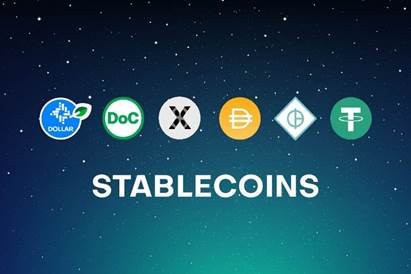Description

Disclaimer: Copyright infringement not intended.
Context
- Crypto critics are using the collapse of dollar-pegged virtual currency Terra USD as ammunition to attack stablecoins and the crypto industry as a whole.
What is Stablecoin?
- A stablecoin is a digital currency that is pegged to a “stable” reserve asset like the U.S. dollar or gold.
- Stablecoins are designed to reduce volatility relative to unpegged cryptocurrencies like Bitcoin.
Details
- A stablecoin is one type of cryptocurrency that is designed to maintain a fixed value over time. The value of a stablecoin is typically pegged to a specific real currency, often the U.S. dollar.
- In this setup, one unit of the cryptocurrency typically equals one unit of the real currency. Unlike highly volatile cryptocurrencies such as Bitcoin, the price of stablecoins is not meant to fluctuate.
Importance
- Digital currencies like Bitcoin and Ethereum are tremendously volatile, which makes pricing things in their terms very difficult. Stablecoins avoid this issue by locking their prices to a known reserve currency.
- In addition, their stability allows many stablecoins to be used as a functional currency within a crypto brokerage. For example, traders might convert Bitcoin into a stablecoin such as Tether, rather than into dollars.
- Stablecoins are available 24/7, making them more accessible than cash obtained through the banking system, which is closed overnight and on weekends.
- Stablecoins can also be used with smart contracts, which are a kind of electronic contract that is automatically executed when its terms are fulfilled. The stability of the digital currency also helps circumvent disagreements that could arise when dealing with more volatile cryptocurrencies.

What are the risks of stablecoins?
- Security: Like other cryptocurrencies, stablecoins must be held somewhere, whether digital wallet or with a broker or exchange. And that presents risks since a given trading platform may not be secure enough or may have some vulnerabilities.
- Counterparty risk: While it may seem like cryptocurrency is highly decentralized, in reality one has to deal with several parties in a transaction, including the bank holding the reserves and the organization issuing the stablecoin. They must be doing the right things (security, properly reserving, etc.) for the currency to maintain its value.
- Reserve risk: A key element of the stable-coin ecosystem are the reserves backing a stablecoin. Those reserves are the last backstop on a stablecoin’s value. Without them, the coin issuer cannot guarantee the value of a stablecoin with full confidence.
- Lack of confidence: If a stablecoin is not sufficiently backed by hard assets, especially cash, it could suffer a run and lose the peg against its target currency. That’s effectively what happened to the algorithmic stablecoin TerraUSD in May 2022, since it wasn’t backstopped by cash but rather by other cryptocurrencies. The price of the stablecoin broke and spiraled downward, as traders lost confidence in its ability to maintain the peg.
Bottom line
- Stablecoins provide some of the stability that is lacking in most cryptocurrencies, making them unusable as actual currency. But those using stablecoins should know the risks they’re taking when they own it. While in most periods it may seem like stablecoins have limited risks, stablecoins may become the riskiest in a crisis when it ought to be the safest to own them.
https://www.ft.com/content/39681aa2-aa01-4d60-b399-8ecb236c627e
















